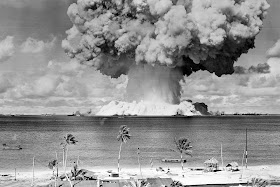 |
| Credit: Bettman/Getty Images |
 |
| Credit: Neil Sands, AFP/Getty Images |
APPETIZER
Nearly ninety (90%) percent of Marshall Island's non-aid income comes from the tuna industry. To that end, the Marshall Islands started its own tuna company in partnership with the Nature Conservancy. The company, Pacific Island Tuna, is the first step for this country to enter into a market that is dominated by foreign fleets, mostly from China and Japan.
The step enables the Marshallese to own the fish that are sold (which are certified as sustainable by the Marine Stewardship Council), thereby ensuring that the proceeds stay in the country. Forty percent (40%) of the net income will be invested in community based conservation efforts and climate resiliency projects. The remaining sixty percent (60%) goes to the island government.
I begin my challenge with an appetizer in recognition of the innovation and leadership demonstrated by the Marshallese people as they try to conserve an important resource and use proceeds in positive ways, such as improving the communities, marine conservation, and fighting climate change. This was also a very delicious start to the meal.
TUNA SASHIMI
Recipe from Delicious.com
Serves 2
Ingredients:
- 500 grams (1 pound) sashimi grade tuna
- 2 avocados, flesh cut into thick slices
- 2 tablespoons extra virgin olive oil
- 1 tablespoon lime juice
- 4 spring onions, finely sliced on the diagonal
- 1/2 cup light soy sauce
Directions:
1. Prepare the tuna and avocado. Using a sharp knife, cut the tuna into 0.5 cm (or 0.2 inch) slices. Place on a serving platter with the slices of avocado.
2. Prepare the dressing. Combine the extra virgin olive oil and lime juice. When ready to serve dress the avocado and tuna with lime dressing. Garnish with spring onions and season with sea salt and pepper.
3. Finish the dish. Serve with soy sauce for dipping and extra lime, if desired.
MAIN COURSE
Now, I turn to the culinary challenge itself: to make a main course from the Marshall Islands. I drew inspiration from the fishing heritage of the Marshallese people (after all, as noted above, they have fifty different words for fishing techniques in their native language). The main course is known as Marshallese Grilled Fish.
This grilled fish dish is traditionally prepared by marinating the fish first in "so-shoe" (soy sauce) and then grilling the entire fish (including the guts) over a fire made with coconut husks. I followed the traditional marinade, but the rest of the recipe did not quite follow the tradition. As a routine, I had my fish gutted and scaled at the grocery store. I also lacked coconut husks to use in the grilling process.
The dish was relatively easy to prepare. The hardest part was deciding on the fish to use. The fishing fleets that patrol the waters of the Marshall Islands usually land bigeye tuna, yellowfin tuna, blue marlin, black marlin, albacore tuna and swordfish. None of those were readily available whole at any market near me.
However, I decided to go with a yellowtail amberjack. Nevertheless, I felt it was appropriate because the Yellowtail Amberjack is a nod to marine conservation generally. The Monterey Bay Aquarium rates this fish either a "best choice" or a "good alternative" depending upon whether the fish is raised through aquaculture and/or where that takes place. I marinated the whole fish (minus the guts) in soy sauce and then grilled it on my gas grill (not authentic at all). My one regret is not getting a picture of the fish before I started to deconstruct it to serve as the main course for myself and my beautiful Angel.
MARSHALLESE GRILLED FISH
Recipe from International Cuisine
Serves 2
Ingredients:
- 1 whole fish, cleaned
- Coconut oil, for basting
- 1/4 cup soy sauce
- Freshly ground black pepper
- Sea salt
- 1 pineapple, peeled and cut into rings or chunks
Directions:
1. Prepare the fish. Clean the fish inside and out and pat dry. Marinate the fish in the soy sauce on both sides for about 20 minutes. Brush with some coconut oil. Season with salt and pepper.
2. Grill the fish. Place the fish in a fish basket for grilling so you can flip it without sticking to the grill. Place on a medium-hot grill and cook both sides for about 5 to 6 minutes or until the fish is flaky and tender. Do not overcook.
3. Grill the pineapple. As the fish is being grilled, add the pineapple to the grill. Grill for 1-2 minutes and flip. Grill for another 1 minute.
3. Finish the dish. Serve the fish whole with grilled pineapple and chukuchuk.
SIDE DISH
This side dish calls for the use of calrose rice, although I had a lot of sushi rice at hand. So, I substituted sushi rice, which worked well in terms of making the rice balls. In fact, it worked a little too well as I ended up pretty much with sticky rice. That stickiness ensured that the final product would be a coconut rice ball. These rice balls are served on special occasions and are often served alongside grilled fish.
CHUKUCHUK
Recipe from International Cuisine
Makes 12 balls
Ingredients:
- 2 cups calrose rice
- 1 coconut, meat shredded/grated
Directions:
1. Prepare the rice. Prepare the rice in accordance with the directions on the package.
2. Continue preparing the rice. When the rice is cool enough to handle, roll the rice into balls and then roll the balls on the grated coconut.
 |
| Credit: Karl Fellenius, AFP/Getty Images |




No comments:
Post a Comment